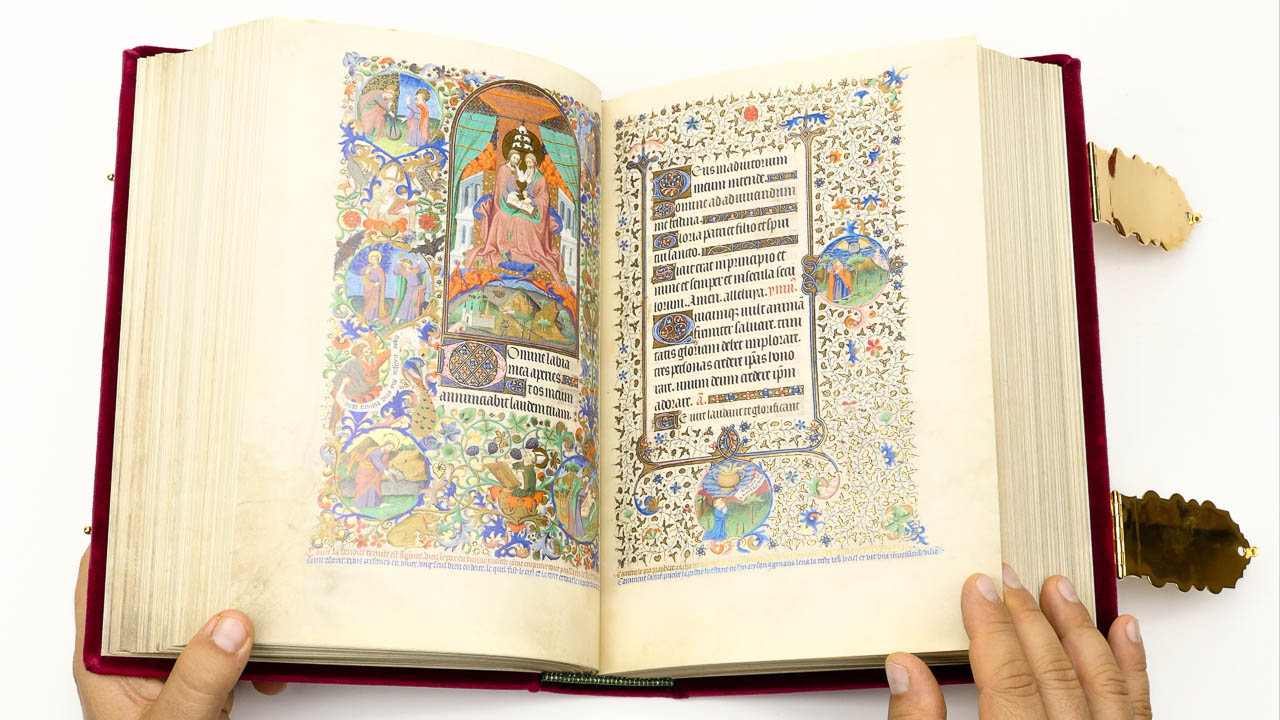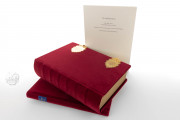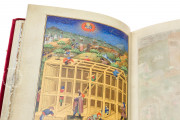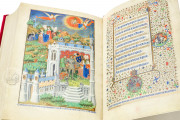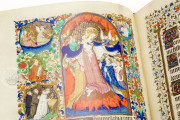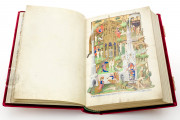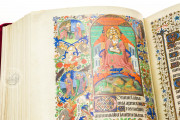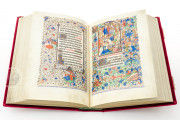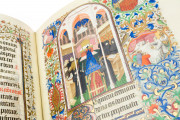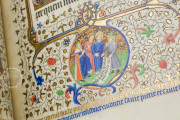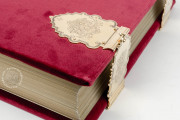Among the finest books of hours produced in Paris in the early decades of the fifteenth century, the Bedford Hours is a masterpiece of the International Style of painting. Each of its nearly 600 pages has some form of illumination. Seven pages feature a full-page miniature, and another thirty-one a three-quarter-page miniature, all with ornately painted borders, and there are twenty-four bas-de-page calendar miniatures situated within painted borders. The remaining pages boast borders enhanced with pictorial roundels—more than 1200 in total.
Every page displays vibrant colors and sparkles with burnished gold, making the Bedford Hours one of the most opulent Christian devotional manuscripts to survive from medieval Europe. Its illumination, which initially involved more than one campaign in the early fifteenth century and then was supplemented in later centuries, is attributed to the Bedford Master (named for this manuscript), the Master of the Munich Golden Legend, the Master of Guy of Laval, the Workshop of the Master of the Cité des Dames, and others.
The Masterpiece of the Bedford Master
The work of the Bedford Master has been identified in several sumptuous manuscripts made in early fifteenth-century France, including the Grandes Heures of the Duke of Berry, although debates continue about these attributions. The hallmark of his style is its reliance on color, rather than delineation, for its effect. His work is especially admired for the elegant rendition of women and youths. He was responsible for most of the miniatures in the Bedford Hours, including the full-page miniatures of the Duke and Duchess of Bedford (fols. 256v and 257v).
A Sophisticated Picture Cycle
As renowned as the manuscript is as a showpiece for the work of the Bedford Master, it is equally admired for the sophisticated program of illumination in its painted borders. The roundels in the borders of pages without miniatures present a series of scenes from the Gospels with Old Testament scenes understood to have a typological relationship to the pictured events from the life of Christ (fols. 19v-94v); scenes from the Acts of the Apostles and the Epistles paired with scenes from Old Testament or later Christian history (fols. 96v-170r); and scenes from the Apocalypse with scenes understood as their "moralizations" (fols. 170v-253r).
Grand Presentation
The text, written in Gothic Textualis, is elegantly written. The main text is articulated by many painted initials and line fillers. Most remarkable are the captions in gold and blue at the bottoms of most pages that describe in French the subjects of the scenes in the roundels. These are thought to have been added in 1430 when the manuscript was given to the young Henry VI (1421-1471), King of England (and France).
A Change in Patronage and a Precious Gift
The manuscript began as a commission for a member of the French royal family, perhaps Louis, Duke of Guyenne (1397-1415), but early on the book was adapted for John Plantagenet (1389-1435), Duke of Bedford, and his wife, Anne of Burgundy (d. 1432), after their marriage in 1423. Their portraits are included in the book (fols. 256v and 257v). Anne gave the book in 1430 to Henry VI.
Illustrious Owners
The manuscript remained in France, and in the sixteenth century was owned by Henry II (1519-1559), King of France, and his consort Catherine de Médicis (1519-1589). Among later owners were Frances Worsley (1673-1750), Edward Harley (1689-1741), Earl of Oxford, and Margaret Cavendish Harley (1715-1785), Duchess of Portland. The arms both of the Harleys and of Henry and Catherine can be found in the book (fols. ii recto and 15r).
Subsequently owned by George Spencer Churchill (1766-1840), Duke of Marlborough, and by John Tobin (1763-1851), it was purchased by the British Museum in 1852. The holdings of the library of the British Museum were transferred to the British Library when it was established in 1973.
We have 1 facsimile edition of the manuscript "Bedford Hours": Bedford-Stundenbuch facsimile edition, published by Faksimile Verlag, 2006
Request Info / Price
